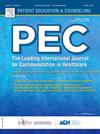Are AI chatbots concordant with evidence-based cancer screening recommendations?
IF 2.9
2区 医学
Q2 PUBLIC, ENVIRONMENTAL & OCCUPATIONAL HEALTH
引用次数: 0
Abstract
Objective
This study aimed to assess whether information from AI chatbots on benefits and harms of breast and prostate cancer screening were concordant with evidence-based cancer screening recommendations.
Methods
Seven unique prompts (four breast cancer; three prostate cancer) were presented to ChatGPT in March 2024. A total of 60 criteria (30 breast; 30 prostate) were used to assess the concordance of information. Concordance was scored between 0 and 2 against the United States Preventive Services Task Force (USPSTF) breast and prostate cancer screening recommendations independently by international cancer screening experts.
Results
43 of 60 (71.7 %) criteria were completely concordant, 3 (5 %) were moderately concordant and 14 (23.3 %) were not concordant or not present, with most of the non-concordant criteria (9 of 14, 64.3 %) being from prompts for the oldest age groups. ChatGPT hallucinations (i.e., completely made up, non-sensical or irrelevant information) were found in 9 of 60 criteria (15 %).
Conclusions
ChatGPT provided information mostly concordant with USPSTF breast and prostate cancer screening recommendations, however, important gaps exist. These findings provide insights into the role of AI to communicate cancer screening benefits and harms and hold increased relevance for periods of guideline change.
Practice implications
AI generated information on cancer screening should be taken in conjunction with official screening recommendations and/or information from clinicians.
求助全文
约1分钟内获得全文
求助全文
来源期刊

Patient Education and Counseling
医学-公共卫生、环境卫生与职业卫生
CiteScore
5.60
自引率
11.40%
发文量
384
审稿时长
46 days
期刊介绍:
Patient Education and Counseling is an interdisciplinary, international journal for patient education and health promotion researchers, managers and clinicians. The journal seeks to explore and elucidate the educational, counseling and communication models in health care. Its aim is to provide a forum for fundamental as well as applied research, and to promote the study of organizational issues involved with the delivery of patient education, counseling, health promotion services and training models in improving communication between providers and patients.
 求助内容:
求助内容: 应助结果提醒方式:
应助结果提醒方式:


